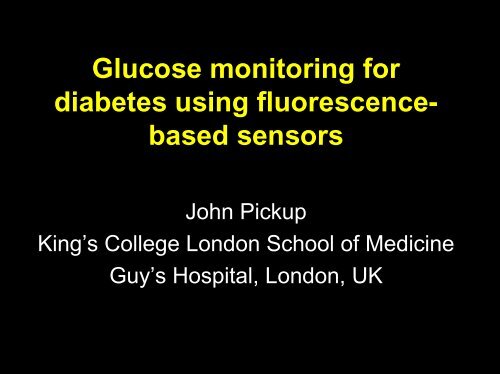Glucose monitoring for diabetes using fluorescence ... - test page
Glucose monitoring for diabetes using fluorescence ... - test page
Glucose monitoring for diabetes using fluorescence ... - test page
- No tags were found...
Create successful ePaper yourself
Turn your PDF publications into a flip-book with our unique Google optimized e-Paper software.
<strong>Glucose</strong> <strong>monitoring</strong> <strong>for</strong><strong>diabetes</strong> <strong>using</strong> <strong>fluorescence</strong>basedsensorsJohn PickupKing’s College London School of MedicineGuy’s Hospital, London, UK
The problem of <strong>diabetes</strong>
Diabetes mellitusA condition characterized by achronically raised blood glucoseconcentration, and due to a relative orabsolute lack of insulin
Diabetes: a global health problemThe Independent:Thursday 6 October 2005The TimesFriday 18 May 2007
The problem of <strong>diabetes</strong>• Diabetes is a global epidemic• 250 million people have <strong>diabetes</strong> worldwide• Prevalence will rise to 380 million by 2025• 10% of healthcare spending in many countries• 3.8 million people die from <strong>diabetes</strong> every year
Diabetic tissue complications• Diabetic retinopathycommonest cause ofblindness in workingage• People with <strong>diabetes</strong>have 15 times thefrequency of legamputations ashealthy individualsDiabetic retinopathyIschaemictoe
The long tradition of <strong>diabetes</strong> careat Guy’s Hospital, LondonGuy’s Hospital, London in the 18 th Century
For exampleSir William Gull (1816-90)• Physician to QueenVictoria• First to describediabetic kidneydisease• Other activities…
Sir William GullWidely believed to be ‘Jack the Ripper’!(note background <strong>fluorescence</strong> in Victorian age)
The problem of glucose<strong>monitoring</strong> in <strong>diabetes</strong>Fluorescence-based sensing as apossible solution
Blood glucose <strong>monitoring</strong>Detect high and low blood glucose→ Adjust therapy to maintain normoglycaemiaHigh blood glucose + timeConventional finger-prick<strong>monitoring</strong>Tissue complicationsretinopathy
Problems with intermittent bloodglucose <strong>monitoring</strong>• Painful→ Non-compliance• Can’t be per<strong>for</strong>medduring sleeping, drivingetc• Intermittent <strong>test</strong>ing maymiss episodes of hyperorhypoglycaemiaBlood glucose (mmol/l)Blood glucose (mmol/l)Blood glucose (mmol/l)Blood glucose (mmol/l)30 30202010100024 8 16 24 8 16 24 8 16 2424 8 16 24 8 16 24 8 16 24303020201010Testing x3-4 per dayTime (h)Time (h)Testing x4-5 per day024 8 16 24 8 16 24 8 16 240Time (h)24 8 16 24 8 16 24 8 16 24Time (h)
The ideal glucose <strong>monitoring</strong>technology• Continuous sensing• Minimally invasive or non-invasive
Some technologies <strong>for</strong> continuous invivo glucose sensingCurrent invasive/semi-invasiveImplanted enzyme electrodesMicrodialysis probesNon-invasive technologies (not in clinical practice)Near-infrared spectroscopyImpedance spectroscopyetc
Amperometric enzyme electrodes+700 mV Inner membrane<strong>Glucose</strong> oxidaseOuter membranePlatinum<strong>Glucose</strong> oxidase<strong>Glucose</strong> + O 2 -> H 2 O 2 + gluconic acid+700 mVH 2 O 2 -> 0 2 + 2H + + 2e -
Present needle-type sc implanted enzymeelectrodesBlood glucoseSensor glucose
Continuous glucose <strong>monitoring</strong>(CGM) at presentThe problems• Impaired responses invivo– Frequent recalibration– Sub-optimal accuracy• Invasive and unreliable
We need a new sensingtechnologyFluorescence as an alternative toelectrochemistry <strong>for</strong> glucosesensors
Advantages of <strong>fluorescence</strong>-basedsensing• Sensitive (potentially single-molecule detection)• With NIR light, non-invasive• Free from electro-active interference in tissues• Can measure <strong>fluorescence</strong> intensity and lifetime
Fluorescence lifetime• Lifetime independent of intensity(unaffected by light scattering in tissues,fluorophore concentration andphotobleaching)• Good <strong>for</strong> in vivo use – not affected byprotein or cell coating of a sensor intissues
Fluorescence-basedglucose sensors• Fibre-optic glucosesensor in SC tissue• ‘Smart tattoo’ conceptof implanted glucosemicro- or nanosensors <strong>for</strong>non-invasive <strong>monitoring</strong>NIR lightFluorescence
Cellular <strong>fluorescence</strong> <strong>for</strong> glucose<strong>monitoring</strong>ExciteEmitIntrinsic <strong>fluorescence</strong> of cells/fluorescent reporter of cell metabolism
Fluorescence biosensors<strong>Glucose</strong>ReceptorFluorescenceLectin (Con A)Enzyme (glucose oxidase, hexokinase)Boronic acid derivativeCellBacterial glucose-binding protein
FRET sensing of glucose based on Con AFRET reducedConA = Concanavalin A,APC = allophycocyanin,MG = malachite green0.8FRET (Gamma)0.70.60.5Problems:Con A toxicityCon A aggregates0.40 5 10 15 20 25 30<strong>Glucose</strong> (mmol/l)McCartney LJ, Pickup JC, Rolinski OJ, Birch DJS.. Anal Biochem 2001; 292: 216-221.
Intrinsic <strong>fluorescence</strong> ofhexokinase• Hexokinase has strongintrinsic <strong>fluorescence</strong>,attributed to tryptophanresiduesFluorescence812700600500400300200100Ex 295,Em 320-340 nm0280 300 320 340 360 380 400 420 440Emission/nm• <strong>Glucose</strong> binding inducesclosing of the two lobesof the enzyme andchangein <strong>fluorescence</strong><strong>Glucose</strong>
Intrinsic <strong>fluorescence</strong> of hexokinasedecreases on addition of glucose820<strong>Glucose</strong>Fluorescence intensityintensity/nm7707206706205705200 5 10 15 20 25 30time/minsTime (min)Hussain F, Birch DJS, Pickup J. Analyt Biochem 2005; 339: 137-43.
Intrinsic <strong>fluorescence</strong> of hexokinase in sol-gelmatrix (extended Kd, no interference inserum)100(a)Fluorescence (%)9080SerumPBSPossible problem:only 20% changein <strong>fluorescence</strong>700 20 40 60 80 100 120<strong>Glucose</strong> (mM)Hussain F, Birch DJS, Pickup J. Analyt Biochem 2005; 339: 137-43.
Non-invasive glucose sensing bymeasuring cellular auto<strong>fluorescence</strong>• <strong>Glucose</strong> induces changes in cellular NAD(P)Hwhich can be monitored non-invasively by its<strong>fluorescence</strong>• NAD(P) is non-fluorescent,NAD(P)H is fluorescent (ex 340 nm, em 450 nm)• ?Possible to measure glucose by skin-surface<strong>fluorescence</strong>
<strong>Glucose</strong>-derived NAD(P)H• Glycolysis• Tricarboxylic acid (Krebs) cycle• Hexose monophosphate pathway(NADPH)• Sorbitol pathway
Real-time changes inauto<strong>fluorescence</strong> of cells in cultureFluorescence1.81.71.61.51.41.31.21.110.90.8<strong>Glucose</strong> 25 mmol/l0 5 10 15 20 25Time (min)MIN6AdipocytesFibroblastsEvans ND, Gnudi L, Rolinski OJ, Birch DJS, Pickup JC.Diabetes Technol Therapeut 2003; 5: 807-816.
Auto<strong>fluorescence</strong> of adipocytes increaseswith glucose1.5Fluorescence1.41.31.21.1No treatmentInsulin10.90 10 20 30 40<strong>Glucose</strong> (mmol/l)Evans ND, Gnudi L, Rolinski OJ, Birch DJS, Pickup JC.Diabetes Technol Therapeut 2003; 5: 807-816.
Fluorescent markers ofmetabolism
Rhodamine 123 (mitochondrial dye):<strong>fluorescence</strong> of adipocyte and fibroblast
Rhodamine 123 <strong>fluorescence</strong> of fibroblasts isquenched by glucoseEvans ND, Gnudi L, Rolinski OJ, Birch DJS, Pickup JC. Photobiol Photochem B 2005; 80: 122-9.25 mmol/l <strong>Glucose</strong>Fluorescence105100959085800 5 10 15 20Time (min)<strong>Glucose</strong>-induced NADH in mito → hyperpolarization of inner membrane → upakeof cationic dye into mito → aggregation of dye → intermolecular quenching
Bacterial glucose/galactosebinding protein
Bacterial glucose-binding proteinC terminus<strong>Glucose</strong>N terminus
The stategy of <strong>fluorescence</strong>-basedglucose sensing <strong>using</strong> GBP• Engineer mutant of GBP with cysteine nearglucose binding site• Attach environmentally sensitive fluorophore(badan) to cysteine• <strong>Glucose</strong> binding decreases polarity around dye• Fluorescence of badan changes
Fluorescence lifetime of an environmentallysensitive fluorophore (badan)Software used to derive multiple decay componentswith different lifetimesFluorescence decay inorganic solventFluorescencedecay in water
adanLabelling of GBP <strong>for</strong> polarity-sensitiveglucose detectionGBPlabelled withbadan at cysmutation near binding sitePolarity around fluorophorereduced:<strong>fluorescence</strong>increased 300%Khan F, Gnudi L, Pickup JC.Biochem Biophys Res Commun 2008; 365: 102-106.
Layer-by-layer encapsulation of sensors innano-engineered membranesTemplate3Sensing proteinCaCO 3 CaCO CaCO 3Proteinadsorbed to CaCO 3dissolution with EDTAAlternating layers ofpoly-lysine and poly-glutamic acidassembled ‘layer-by-layer’
<strong>Glucose</strong> increases <strong>fluorescence</strong> ofmicrosensorsλex = 400 nmλem = 550 nmGBP-Badan capsulesGBP-badan without microcapsulesglucosewithout glucoseGBP-Badan capsules withGBP-badan microcapsules withglucose100 µM glucose
GBP-badan <strong>fluorescence</strong> lifetime increaseson addition of glucoseBi-exponential decayShort lifetime component ~0.8 nsLong-lifetime component ~3.1 ns310 µM glucoseZero glucose
GBP has two components : longand short <strong>fluorescence</strong> lifetime• Long lifetime component = closed <strong>for</strong>m ofGBP with bound glucose (badan inhydrophobic environment)• Short lifetime component = open <strong>for</strong>m ofGBP with no bound glucose (badan inpolar environment)
<strong>Glucose</strong> increases closed <strong>for</strong>m of GBPFraction of long-lifetime <strong>for</strong>m increases(Closed <strong>for</strong>m of GBP increases)Fraction of short-lifetime <strong>for</strong>m decreases(Open <strong>for</strong>m of GBP decreases)
Requirements <strong>for</strong> in vivo use• Increasing the Kd of GBP so that sensoroperates in pathophysiological range• Stable operation over time• Operation in biological fluids
Extending the operating range ofGBP-badan<strong>Glucose</strong> response of GBP-badan and its mutants∆ Fluorescence500250H152C Mutant A (H152C)H152C/A213RMutant B (2 changes)H152C/L238SMutant C (2 changes)H152C/A213R/L238SMutant D (3 changes)0.0001 0.01 1 100 10000[glucose] mM
Mutant D has highest known Kd ofany GBP mutant200 K d ~ 12 mM∆ Fluorescence1000.1 1 10 100 1000[glucose] mM
GBP-badan <strong>fluorescence</strong> lifetime changewith glucose at 0 and 5 hoursHigh glucosetime 0 and after 5 hrZero glucosetime 0 and after 5 hr
<strong>Glucose</strong> response of GBP-badan inbuffer and serum∆ Fluorescence200100K d ~ 12 mMK d ~ 14 mMPBSSerum0.1 1 10 100 1000[glucose] mM
FLIM(<strong>fluorescence</strong> lifetime imagingmicroscopy)
Using FLIM to imageglucose sensorsEach pixel has <strong>fluorescence</strong>intensity and lifetimeLifetime converted to colourBlue-shortRed- long
Fluorescence lifetime imagingmicroscopy (FLIM) of microsensors<strong>Glucose</strong>IntensityFraction oflong lifetimeclosed <strong>for</strong>mof GBPPixel histogrameach image
Summary (1)• Reliable and accurate glucose <strong>monitoring</strong>is a major problem in <strong>diabetes</strong> awaiting asolution• Technology based on <strong>fluorescence</strong>sensing of glucose is a promisingapproach
Summary (2)• Fluorescence-based glucose sensors haveadvantages over enzyme electrodes• Fluorescence lifetime measurements in thenanosecond range are best <strong>for</strong> in vivo sensing• Fluorophore-labelled glucose-binding proteinencapsulated in nano-engineered capsules orimmobilised on a fibre optic probe has potential<strong>for</strong> glucose sensing



![Fluorescence Lifetime Imaging Microscopy Microscopy [FLIM]](https://img.yumpu.com/42693511/1/190x143/fluorescence-lifetime-imaging-microscopy-microscopy-flim.jpg?quality=85)
